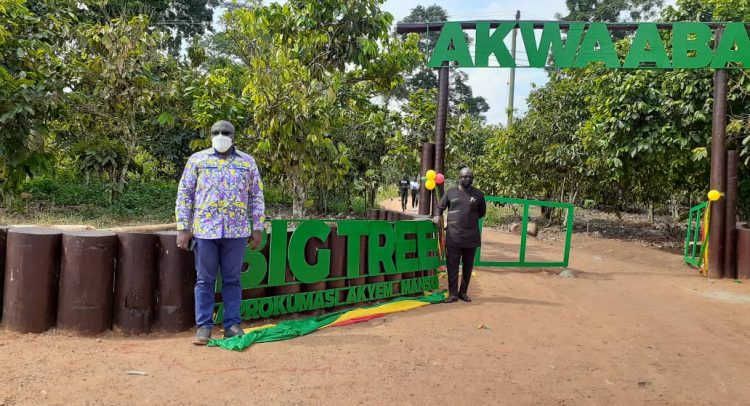The “Oda Big Tree” believed to be the biggest in West Africa is of the Bako species with Tieghemela Heckle as its botanical name.
The Oda Big Tree site, though it has existed for over 400 years, was not a tourist site until 2004 when the then Minister of Tourism and Modernization of the Capital City, Jake Obetsebi-Lamptey designated this place as a tourist site.
However, the current NPP administration through the Ghana Tourist Authority in collaboration with Malin Construction Limited signed an MoU as part of the measures to get more tourist sites in the country to creates jobs.
The two parties have managed to re-develop the project, involving the renovation of the receptive facility which was constructed for the Big Tree as a tourist site, upgrading of the entrance and also the hiking trail to the Asiapam Forest Reserve where the Big Tree is located as well as the Asubone Forest Reserve.
They also constructed a modern rest stop with a restaurant attached, a well-paved open space to host events reception that’s for wedding, birthday, naming and outdooring, church conventions among others.
Minister for Tourism, Art and Culture, Ibrahim Mohammed Awal who commissioned the tourist site on Wednesday, June 23, 2021 promised that, under his watch as Minister, he will make sure “Oda Big Tree” becomes one of the best tourist sites in West Africa.
He, therefore, charged the Ghana Tourism Development Company and Ghana Tourism Federation to ensure that within one year, 3,000 visitors troop into Aprokumase to visit the “Big Tree” to generate 250 jobs for Akyem Manso and its environs annually.
The Tourism Minister, noted that 250,000 people from the diaspora are expected to visit the “Oda Big Tree” at the last quarter of the year of the “Beyond the Return” project to generate income for the people of Akyem Manso.
“In the last quarter of this year, we are expecting 250,00 people from the diaspora under the Beyond the Return project. They will all come here to see the Big Tree and that will generate hundreds of US dollars for the people of this area.”
He urged the chiefs and residents of Akyem Manso to take good care of the site for it to last long for the next generation to benefit from it.
The Chief Executive Officer (CEO) of the Ghana Tourism Development Company, Kwadwo Odame Antwi said “as part of our planned programme to improve existing tourist site, we took stocks on the list of the existing tourist site and look at which has the biggest potential to improve tourism travel and will make the biggest impact on the local economy.
The Eastern Regional Minister, Seth Acheampong revealed that government was determined to put more efforts into most of the tourism sites in Ghana to create jobs and brings economic life-changing to the lives of Ghanaians.
“We have no doubt as a government that tourism has the potential to engineer the growth we seek, create jobs, and bring about the economic transformation in the lives of the people.
“Government is therefore determined to invest in most of the tourist attractions across the country and we in the Eastern Region are focused on upgrading existing sites and developing newly discovered ones as part of this national agenda,” he said.
He continued that the government of President Akufo-Addo, since coming into power has invested heavily in the tourism and creative arts economy.
He congratulated the Minister of Tourism, Art and Culture, and CEO of GTDC for the re-development of the facility fully through its internally generated revenue and also thanked Obrempong Sintim Poku III and the entire Traditional Council for their support in the execution of the project.
The Oda big tree many believe is located in the Essen-Apam Forest Reserve, documents at the Forestry Commission suggest that the tree stands is in the Asuboni Forest Reserve.
It has a diameter of 3.22 meters at 1.37 meters, 2.72 meters at 3.1 meters, making 12 meters in circumference and 66.5-90 meters tall and girth is 10.11 metres at 1.4 metres and 8.63 metres at 3.1 meters.
FROM Daniel Bampoe, Aprokumase

